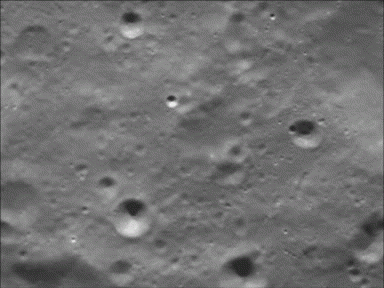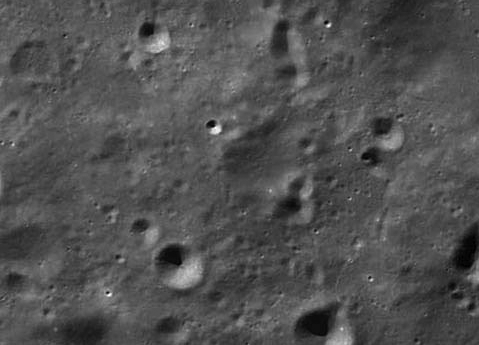Emily Lakdawalla • Dec 03, 2007
No, the Chang'e image isn't fake! -- but there's no new feature in it, either
An update to this story is posted here.
It's a pretty serious accusation, so I tried to track down the images that the Internet rumor is referring to. A complication is that the NASA image is unlikely to be "from 2005" as the articles say; there wasn't a NASA spacecraft in orbit at the Moon in 2005. (Check our lunar missions page for an accounting of the history of lunar exploration.) ESA's SMART-1 was in orbit then, but I had a hunch that the "2005 photo" might refer to a 2005 release of a global mosaic of Clementine image data. The Clementine orbiter was active at the Moon in 1994, acquiring a global map; newly reprocessed and reprojected versions of these data have been coming out in public release lately. (One easy way for you to access these is the handy-dandy PDS Map-a-Planet tool.)
Anyway, the Telegraph article included two images side-by-side, one from Chang'e and one from "NASA." I dug in to the Clementine data and indeed the "NASA" image shown in the Telegraph article was evidently from Clementine's 1994 mission. Here is a single Clementine image -- taken from the original data, not from any reprojected or mosaicked version -- showing the area in question. For the detail-oriented, this is from the UVVIS instrument, the 750-nm channel. I found it using the Clementine data browser at the Naval Research Laboratory's website.

NASA / DOD
Clementine image of the Moon
This image of the Moon, taken on March 21, 1994, is one of thousands captured by Clementine's UVVIS camera as part of its systematic mapping of the lunar surface. It shows an area centered at 67.15°S, 71.84°E at a resolution of 145 meters per pixel. The contrast has been increased slightly to bring out detail.So the notion that China faked their lunar photo can be put to rest. (What is it about the Moon and conspiracy theories, anyway?) At least it certainly isn't a copy of the Clementine image; and it's certainly not a Lunar Orbiter image, either. I am curious -- but don't have the time to hunt -- to see what SMART-1 saw in the same area. But the Clementine/Chang'e 1 comparison contains something exciting: a spot that may have changed between the two images! Both images contain a right-pointing equilateral triangle formed by three smallish craters. The rightmost crater in the Clementine image stands alone, but in the Chang'e 1 image it has an apparently new feature to its lower left. The chief scientist of the Chinese lunar exploration program, Ouyang Ziyuan, was quoted in the Reuters and Telegraph rebuttals of the fake-image accusation as pointing to this spot as proof that the two pictures weren't the same. Amazing! Is this a new crater on the Moon, the place where nothing ever changes? And how ironic that there should be a new feature in an image that was supposed to be "identical" to one taken previously by NASA. Here's the two areas side-by-side:
I don't have time to do it now but I bet if you go back to the original image you can see other places along the same seam where features are offset. It's a bit embarrassing that Ouyang Ziyuan cited the crater as being a new feature when in fact it's just an artifact of their mosaicking process. This is one reason you often see lots of image seams in mosaics produced by space missions, why scientists generally don't take the time to make their images prettier by blending seams away; such blending is, in a sense, a "fakery," making the data looking prettier than it is. It's perfectly okay to clean up images for use as illustrations, and this first Chang'e image release was clearly designed to wow the public. However, because of the blending of the seams, this is not a product that should be used for scientific research -- including looking for new craters. Some of this problem should go away once the Chang'e team improves their knowledge of their spacecraft's orbit and of the shape of the Moon; with more precise positional information, their mosaics will automatically improve, having less obvious seams with smaller offsets.
So, in a way, the story has come full circle. The Chang'e image isn't a fake as far as I can tell; my personal opinion, based upon the evidence I was able to dig up, is that the Chinese do have an orbiter at the Moon, and that it is producing really beautiful images that are a great improvement over Clementine. But the one released image is a processed product, and was altered slightly (the seams were blended away) to make it pretty. This alteration made it difficult for a scientist to realize that what appeared to be a new feature was in fact an artifact.
Being a scientist type myself, I would love, eventually, to get my hands on the original data. And there's good news on that score. According to a Xinhua news story from Sunday, the Chinese Academy of Sciences is making the data available, in a limited way anyway, to the public. Chinese lunar exploration program chief scientist Ouyang Ziyuan is quoted as saying: "The money used for the Chang'e project comes from the taxpayers and, therefore, the data should also be made public. Any scientist or astronomy lover can apply to the state in accordance with certain procedures to obtain data he needs." I invite any Chinese reader of this blog to attempt to get access to the data to help refute the fakery story, and tell me what happens!
Did you like this article? Send it to a friend or share it at:Slashdot - Digg this - Reddit - Del.icio.us - Newsvine - NowPublic
Support our core enterprises
Your support powers our mission to explore worlds, find life, and defend Earth. You make all the difference when you make a gift. Give today!
Donate

 Explore Worlds
Explore Worlds Find Life
Find Life Defend Earth
Defend Earth




